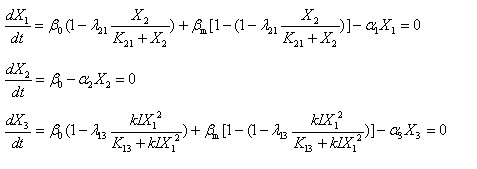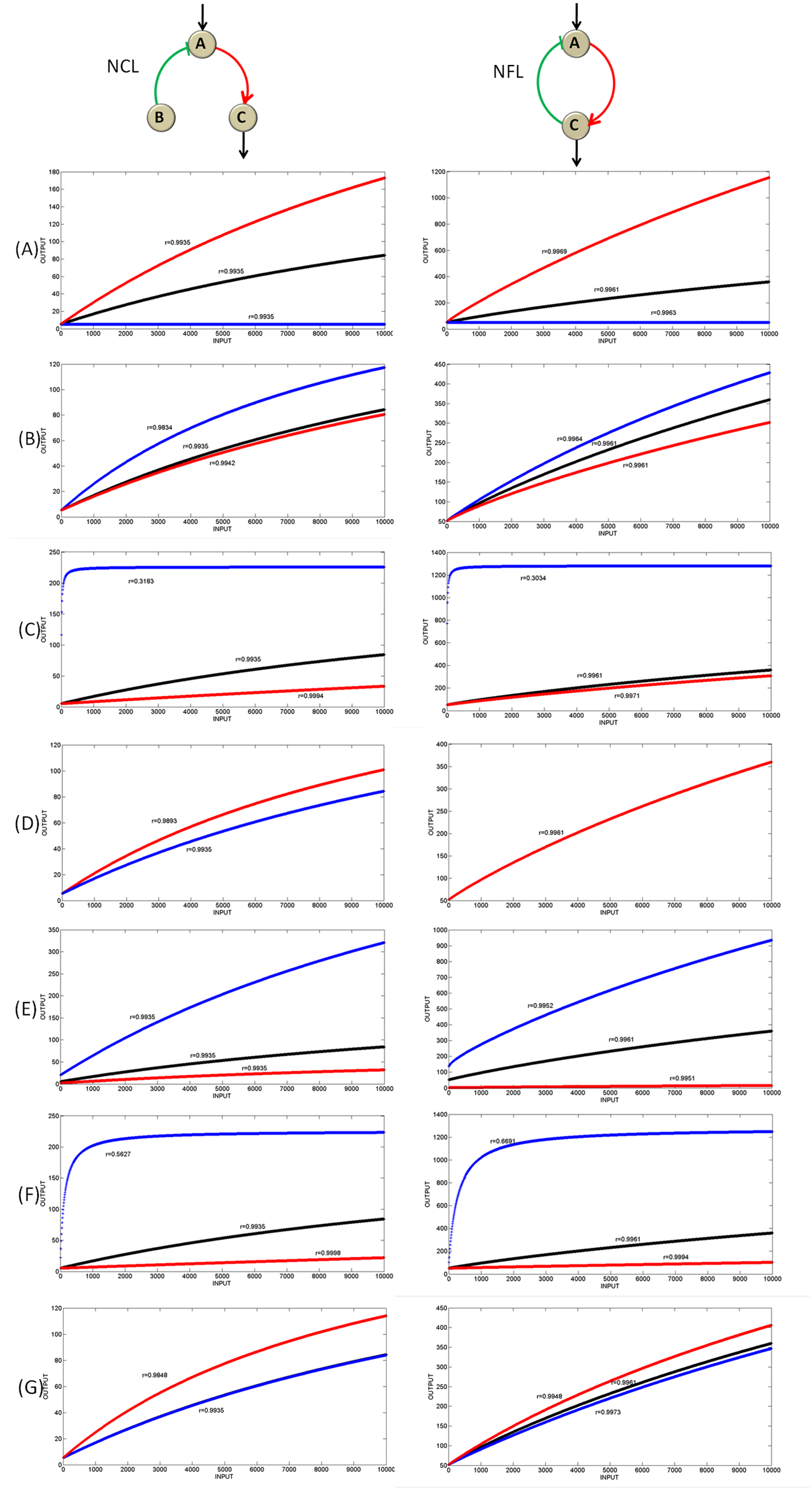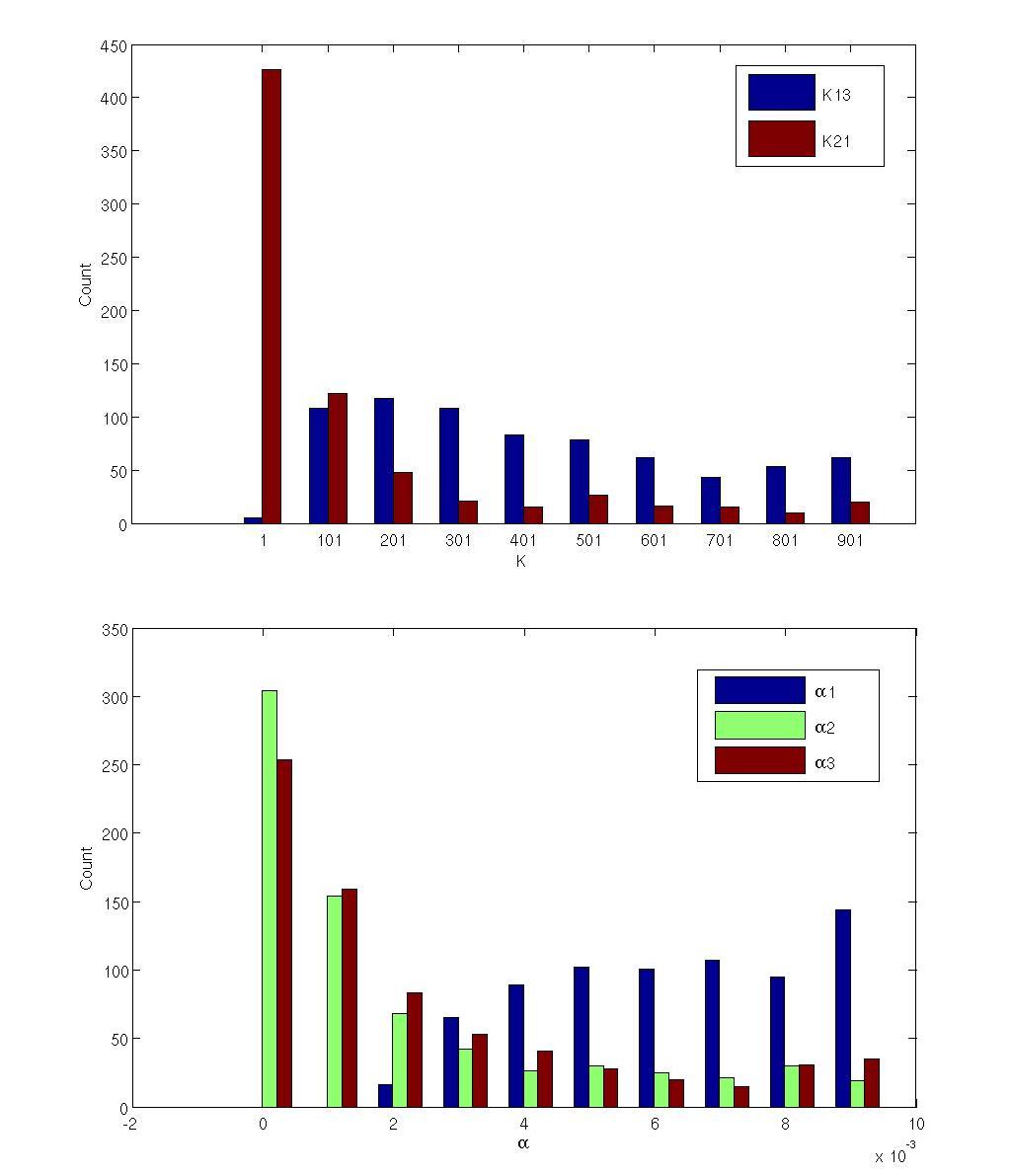Team:Peking/Modeling/Analysis
From 2010.igem.org
(→Analysis of All Possible Three-Node Networks) |
(→Analysis of All Possible Three-Node Networks) |
||
| Line 34: | Line 34: | ||
=Analysis of All Possible Three-Node Networks= | =Analysis of All Possible Three-Node Networks= | ||
The above analyses focused on minimal( less than or equal to 3 links) three-node networks and identified simple topologies that are sufficient for IOA function, also unraveling the mechanism that the topologies work. But whether the topologies are necessary for the IOA function is not understood yet. In other words, are the identified minimal topologies the foundation of all possible networks, or are there more complex higher-order solutions that do not contain these minimal topologies? To answer the questions above, we analysis the first 160 topologies (Q>705) that are well capable of the IOA function.<br> | The above analyses focused on minimal( less than or equal to 3 links) three-node networks and identified simple topologies that are sufficient for IOA function, also unraveling the mechanism that the topologies work. But whether the topologies are necessary for the IOA function is not understood yet. In other words, are the identified minimal topologies the foundation of all possible networks, or are there more complex higher-order solutions that do not contain these minimal topologies? To answer the questions above, we analysis the first 160 topologies (Q>705) that are well capable of the IOA function.<br> | ||
| - | [[Image: | + | [[Image:Kbc.jpg|600px]] |
<br> | <br> | ||
| - | '''Figure | + | '''Figure 10 Distribution of NCL topology parameters which can establish linear response curves'''<br> |
Analysis of these robust topologies shows that they are overrepresented with NCL and NFL. All 160 topologies contain at least one NCL or NFL motif ( or both ). These results indicate that at least one of these motifs is necessary for IOA function. <br> | Analysis of these robust topologies shows that they are overrepresented with NCL and NFL. All 160 topologies contain at least one NCL or NFL motif ( or both ). These results indicate that at least one of these motifs is necessary for IOA function. <br> | ||
Supplementarily, the NCL average Q value(AQV)of all 19683 topologies is 17.14 while the NFL AQV is only 9.36, which again indicate that the NCL is more robust than NFL that have drew conclusion in the minimal topology analysis. | Supplementarily, the NCL average Q value(AQV)of all 19683 topologies is 17.14 while the NFL AQV is only 9.36, which again indicate that the NCL is more robust than NFL that have drew conclusion in the minimal topology analysis. | ||
<br> | <br> | ||
Revision as of 13:35, 25 October 2010

Analyses and Results
Mechanisms of Minimal IOA Networks and Key Parameters Analysis
Aimed at answering the question why the two topologies defined above (Figure 8) is functional in IOA, we unravel their mechanisms using the ODE equations in this part, also getting the parameter restrictions of each topology.
NCL Topology
When the network has built steady state:

Solve the equations:
And the concentration of B node is actually part of the slope coefficient the linear equation, we can imagine that the function of B node is to lower the concentration of A straightly without the interference of other factors as well as control the concentration of A more precisely and more freely to make the parameter restriction easier to achieve and at the same time the output range is not too small. As we know, the stochastic error may make vague the linear relationship when the values of y axis are too near. The lower concentration X2 is, the steeper the line is, and so the bigger the range is, which in biology means that the bioreporter is more sensitive to certain environmental signal. Through modifying the parameters of node B, we can get a proper concentration of A node to achieve a good r. In all, the node B is a proportion node.
NFL Topology

Compare X1 here with the concentration of node A in NCL topology, one can easily discover that X1 here is higher and more dull, which makes it more hard to get a balance between satisfying the second parameter restriction and the need for the range to be rational. Then we can understand why NFL topology is less than NCL in high-Q-value topologies.
Aimed at unraveling the relative importance among parameters, we got all functional sets of parameters of NCL&NFL and selected randomly one set, respectively, from the two topologies and processed them with Matlab to compare the differences once the parameters change. The results are in Figure 9. From changes of the two important characters – the output range and r with the change of parameters (Table 2), we got the answer to previous questions.

Figure 9 Analysis for key parameters We got all functional sets of parameters of NCL&NFL and selected randomly one set, respectively, from the two topologies and processed them with Matlab to compare the differences once the parameters change. When analyzing one parameter, we only change this very parameter and keep others the same, and when we change the parameter to a lower level, we get the blue line, when to a higher level, we get the red line and the black line is for the unchanged parameter set. Each line has its Pearson Correlation Coefficient r marked in the figure. The X Axis is the concentration of Hg ion as INPUT whose range is 1 to 10000 nM, and the Y Axis is the concentration of node C with the unit of nM.
Analysis of All Possible Three-Node Networks
The above analyses focused on minimal( less than or equal to 3 links) three-node networks and identified simple topologies that are sufficient for IOA function, also unraveling the mechanism that the topologies work. But whether the topologies are necessary for the IOA function is not understood yet. In other words, are the identified minimal topologies the foundation of all possible networks, or are there more complex higher-order solutions that do not contain these minimal topologies? To answer the questions above, we analysis the first 160 topologies (Q>705) that are well capable of the IOA function.

Figure 10 Distribution of NCL topology parameters which can establish linear response curves
Analysis of these robust topologies shows that they are overrepresented with NCL and NFL. All 160 topologies contain at least one NCL or NFL motif ( or both ). These results indicate that at least one of these motifs is necessary for IOA function.
Supplementarily, the NCL average Q value(AQV)of all 19683 topologies is 17.14 while the NFL AQV is only 9.36, which again indicate that the NCL is more robust than NFL that have drew conclusion in the minimal topology analysis.
 "
"